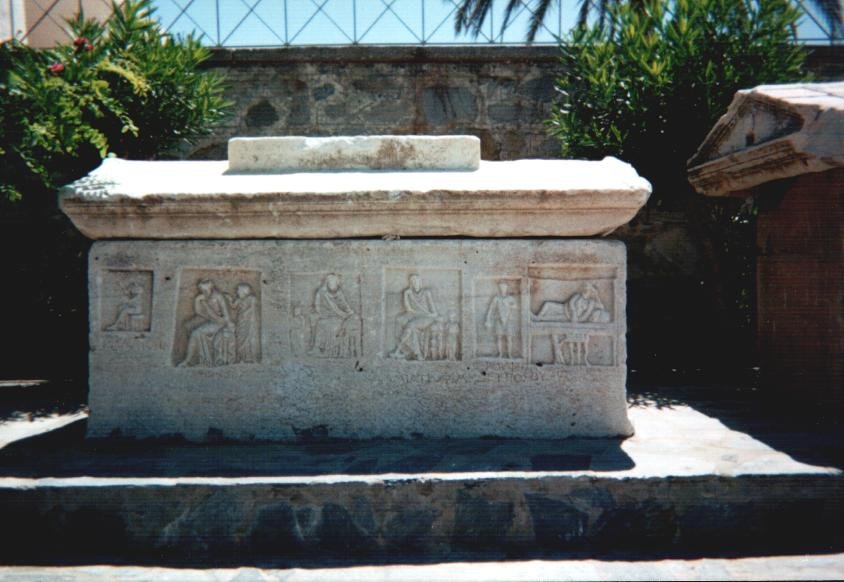As I said in the previous history page the veneer of tourism overlays the numerous ancient sites through out Parikia.
Some are more obvious than others, however. For instance the major church on the island, Ekatontapliani (100 Doors) is one of the top in all Orthodoxy because it is attributed to Roman Emperor Constantine’s mother Helen. Yet for the student of ancient Greece you have to find your way to the front of the main alter where there are Plexiglas covered holes showing the remains of prior buildings purported to be of a temple dedicated to Hercules and Archilochus. Also parts of a temple to Demeter are used in the church complex.

To the right of the ferry quay the old town ascents a steep hill which is topped by a small church which too sits atop a temple. Also next door are limestone deposits that contain pre-historic remains. But what draws the tourists other than the views and the coffee shops is the Frankish Castle (1260 A.D) made from pieces of the previous temples. The round pieces are said to be from a temple to Athena which may have started as a temple to Demeter.
To the left of the ferry quay a short walk past fishing boats on one side and shops on the other you find a large empty space in the development, an ancient cemetery. Most years a little money seems to be available for active archeological digging at this site. It has been going on since 1983 and a great many sarcophaguses have been unearthed. With a great many yet to go as the site extends under the road and out into the current harbor where development is restricted as well. Some are on display at the site and some in the Paros Archeological Museum. The cemetery itself was used from 8th Century B.C. to 2 A.D.


Sarcophagus: from Wikipedia a funeral receptacle for a
corpse, most commonly carved or cut from stone. The
word “sarcophagus” comes from the Greek σάρξ sarx
meaning “flesh”, and φαγεῖν phagein meaning “to eat”,
hence sarkophagus means “flesh-eating”; from the
phrase lithos sarkophagos (λίθος σαρκοφάγος).
Since lithos is Greek for stone, lithos sarcophagos
means ‘flesh-eating stone’. The word came to refer to
a particular kind of limestone that was thought to
decompose the flesh of corpses interred within it.
For our next site we leave the harbor area and walk through town a few blocks towards the main shopping street. Under one of the commercial buildings constructed there you will find an ancient ceramic workshop. This was actually a factory from the 3rd century B.C. with six kilns and two cisterns. Also on the site and across the street are remains of an ancient city wall.
Next we cross the peripheral road and walk to the left until you see the brown signs pointing to the Hellenistic Mosaics. These are various mosaic floors of 3rd century B.C. residences. In one case you can see an even older floor underneath.
Parikia is a typical example of wherever you turn a spade in Greece you will find artifacts.
In this same general area is what is known as the open air sanctuary. There is little to be seen amongst the modern residences, yet it is intriguing to see ordinary people go about their daily lives literally walking over ancient antiquities. If you look hard enough you will find an unfinished kouros and various funerary structures.
Perhaps you are better off to spend the time in the Paros Archeological Museum where much that was excavated in the area can be found. The staff there may be able to point you to specific locations nearby where the items were found. We highly recommend the Museum even though many of the better pieces found on Paros are in the National Archeological Museum in Athens. The local version gives you a real sense of the past grandeur that was once Paros. It includes artifacts of Saliangos, Despotiko and Antiparos.
The next three Parikia area sites can be seen on foot if you are a good hiker but are easier seen by car or motor scooter.
Paros has a long association with the god of healing known as Asclepios. A 4th century B.C. temple to him can be found as you are leaving the town to the South towards Aliki. It is now part of the hillside and all that has been excavated are parts of two reservoirs and stone walls. Ignore the 19th century crypt at the top of the hill. On the same site are the circular foundations to a sanctuary for Pythian Apollo.
In the opposite direction to the North towards Naoussa is the site known as Three Churches. Hundreds of people speed by it every day without giving it a second look. What you primarily see are the ruins of a 17th century church that was built on top of a 6th century basilica which was built on top of a shrine to the poet Archilochus.
Next, if you have the fortitude to climb the high hill past Livadia Beach and above Krios Beach, you will eventually stumble across the Delion Sanctuary. Perhaps the jumble of stones themselves is not worth the hike but the view is. The Apollo temple built in the 9th century B.C. as well as, next to it to the east, the Artemis temple was built to view the gods’ birthplace, the island of Delos. On a clear day you too can see it to the left of Mykonos.
Before journeying on to the ancient sites around the island we recommend a visit to one of the nearby beach bars.